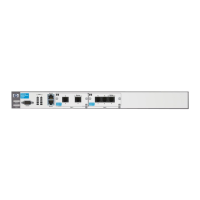1-49
Overview
Software Overview
Debug
Entering debug will display debug messages as packets arrive on the router.
Debugging is useful when troubleshooting or testing your router’s operation.
The Secure Router OS provides many debug commands, including options
for most protocols and processes run on the router.
For a list of debug commands, go to the enable mode context and enter:
ProCurve# debug ?
For example, you could debug the establishment of a PPP connection:
ProCurve# debug ppp negotiation
You can find the exact command syntax for relevant debug commands in the
troubleshooting section of each chapter.
Caution This guide will describe how to use debug commands to troubleshoot your
router. You should be aware that debug commands are processor-intensive
and could seriously degrade network performance.
Dir
This command shows the current files in internal flash or compact flash.
Syntax: dir [flash | cflash] [*.<file extension>]
Use the flash option to list all files in the router’s flash memory. Use the cflash
option to display all the files on the router’s compact flash card.
The * symbol is a wildcard that allows you to specify a file pattern to display.
For example, if you want the router to list all the Secure Router OS files in
internal flash memory, you would enter:
ProCurve# dir flash *.biz
Or if you wanted to display all the router configuration files stored on the
compact flash card, you might enter:
ProCurve# dir cflash *.cfg
Note If you do not specify an option for flash or cflash, the CLI displays only files
in the internal flash.

